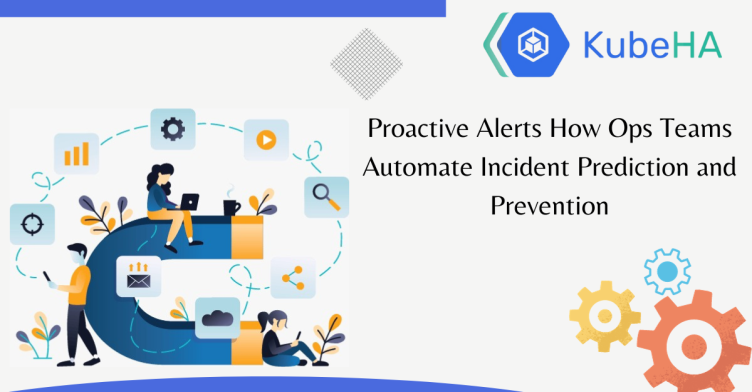
IT operations, the ability to predict and prevent incidents before they impact the system’s stability and performance has become paramount. Proactive alerts, a key component of modern operations strategies, empower teams to stay ahead of potential issues and ensure seamless service delivery. This article explores the significance of proactive alerts and delves into how operations teams leverage automation to predict and prevent incidents effectively.
The Evolution of Incident Management
Traditionally, incident management was primarily reactive. Teams would respond to issues as they occurred, often leading to costly downtime and frustrated end-users. However, as technology advanced and system complexity grew, a shift towards proactive approaches became imperative. This shift gave birth to proactive alerts, enabling operations teams to detect and address potential problems before they escalate.
Understanding Proactive Alerts
Proactive alerts are automated notifications triggered by predefined conditions or thresholds. These conditions can range from abnormal system behavior to performance degradation, security vulnerabilities, and more. By setting up these alerts, operations teams gain real-time visibility into the health of their systems, allowing them to take corrective action swiftly.
Automation: The Engine Behind Proactive Alerts
Automation is the linchpin of proactive alerting systems. Through a combination of monitoring tools, machine learning algorithms, and predefined triggers, operations teams can create a dynamic framework for incident prediction and prevention. Here’s how automation plays a pivotal role:
Continuous Monitoring: Automated monitoring tools tirelessly keep an eye on system metrics, logs, and events. They collect data in real-time and analyze it against predefined thresholds to identify anomalies.
Intelligent Analysis: Machine learning algorithms sift through the collected data to discern patterns and trends. They learn from historical data to differentiate between normal fluctuations and potential indicators of impending incidents.
Threshold-Based Triggers: Operations teams set thresholds that, when breached, trigger an alert. These thresholds are established based on historical data, industry best practices, and the specific requirements of the organization.
Predictive Analytics: By leveraging historical data and predictive analytics, operations teams can forecast potential incidents. This allows for preemptive measures to be taken, minimizing the impact on end-users.
Automated Responses: Once an alert is triggered, predefined responses are automatically executed. These responses can range from simple notifications to complex automated actions aimed at mitigating the incident.
Benefits of Proactive Alerting
Implementing proactive alerting offers a multitude of benefits to operations teams and the organizations they support:
Reduced Downtime: By identifying and addressing issues before they escalate, proactive alerts minimize downtime and ensure uninterrupted service delivery.
Cost Savings: Preventing incidents is far more cost-effective than dealing with their aftermath. Proactive alerts help organizations save money on emergency response, recovery, and potential legal or regulatory repercussions.
Enhanced Customer Satisfaction: Reliable services lead to satisfied customers. Proactive alerts contribute to a positive user experience by ensuring consistent performance and availability.
Improved Resource Allocation: With insights from proactive alerts, operations teams can allocate resources more efficiently, focusing on critical areas that require attention.
Proactive Capacity Planning: Predictive analytics from proactive alerts enable organizations to plan for future growth and scalability, ensuring systems can handle increasing workloads.
Key Components of Proactive Alerts:
Real-time Monitoring: Proactive alerts rely on continuous monitoring of system performance, network traffic, and application behavior. This real-time data collection ensures that anomalies and deviations from normal operations are detected promptly.
Data Analytics: Advanced data analytics techniques, including anomaly detection and pattern recognition, are employed to identify potential issues. These analytics models can process vast amounts of data and recognize subtle patterns that may go unnoticed by human operators.
Machine Learning: Machine learning models are used to train systems to recognize patterns that lead to incidents. These models can predict incidents with high accuracy based on historical data, allowing Ops teams to act proactively.
Automated Responses: When a proactive alert is triggered, automated responses can be initiated, such as scaling resources, diverting traffic, or deploying temporary fixes. These responses are designed to prevent incidents from occurring or to minimize their impact.
Automating Incident Prediction
Data Collection: Ops teams collect and aggregate vast amounts of operational data from various sources, such as logs, metrics, and events. This data forms the foundation for predictive analytics.
Anomaly Detection: Advanced analytics and machine learning models are applied to the collected data to identify anomalies, outliers, and patterns that might indicate potential issues.
Forecasting: Predictive algorithms use historical data to forecast when incidents may occur based on identified anomalies, allowing teams to take preemptive action. Follow KubeHA Linkedin Page KubeHA